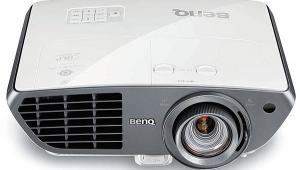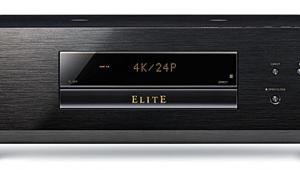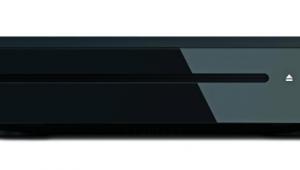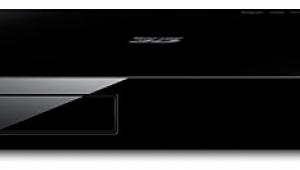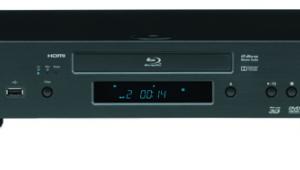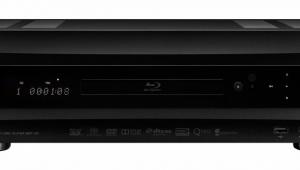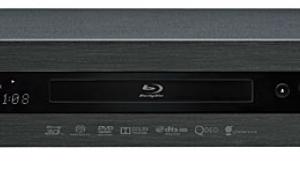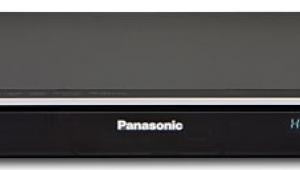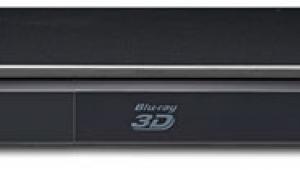Sharp SD-WH1000U Wireless Universal Player Review Page 2
Ergonomics
Ease-of-use results were considerably more mixed. While playing discs, the Sharp was quick and responsive—this clearly is an excellent, up-to-date Blu-ray player design—but its utility with other sources was uneven. Unlike how the typical A/V receiver behaves, Sharp spec’d the SD-WH1000U to pass the HDMI input from any outside source with no video processing.
So incoming video is not scaled
and can’t be tweaked in any way. The Settings menu does include
a Video/HDMI setup submenu
that offers the usual choice of resolution selections, but it only affects disc playback and the unit’s onscreen menus.
Next, the Sharp’s streaming-media feature did not work usably in my system, where my desktop iMac serves up DLNA content via TwonkyMedia, a popular, cheap-ware OSX software server. The SD-WH1000U would play files residing in a folder on my hard disk’s root level, but not any deeper in the file structure, though it did play those root-level DSD and other high-res files without issue.
 Files on USB media plugged directly into the player, however, played fine, with full resolution and satisfyingly high-end sound. What’s more, the Sharp had no problem navigating plug-in USB media to at least five folders deep. Whether the DLNA problem was wholly the Sharp’s or not I cannot say, other than to observe that my iMac/DLNA-server setup has worked smoothly with at least a score of other DLNA clients in A/V receivers, set-top boxes, and other components.
Files on USB media plugged directly into the player, however, played fine, with full resolution and satisfyingly high-end sound. What’s more, the Sharp had no problem navigating plug-in USB media to at least five folders deep. Whether the DLNA problem was wholly the Sharp’s or not I cannot say, other than to observe that my iMac/DLNA-server setup has worked smoothly with at least a score of other DLNA clients in A/V receivers, set-top boxes, and other components.
I encountered a few other oddities with the SD-WH1000U. If you’re watching a disc and pause to switch to an external source attached via HDMI input to watch, say, the weather report (or even if you just switch to the Home menu to adjust a setting), returning to the disc takes an agonizing 20 seconds, and the player forces you back to the main menu, where you must restart from the top or select a chapter. (The traditional resume function, in which you press Stop once and then press Play to return to the last point of viewing, works as long as you don’t change inputs or press Stop a second time.)
Sharp’s brochure specs the SD-WH1000U as “Roku-Stick-ready,” presumably via its one MHL-compliant HDMI input, which is nice. But there are no Internet streaming services on board, which is all but unique among even the cheapest of today’s Blu-ray players. The Sharp’s onboard Wi-Fi found my home network without fuss and worked reliably if (not surprisingly) a bit more slowly than wired Ethernet in terms of track/folder access. As already mentioned, media streaming from my network was unusably spotty either way.
Sharp’s materials mention MP4/AAC file compatibility, but at first the SD-WH1000U would neither recognize nor play MP4/AAC files on any medium. Eventually, a careful read through the manual revealed a tiny notice suggesting that one should attempt a firmware update if the unit fails to play MP4/AAC files, which I did, with positive result. Presumably, new buyers won’t have to jump through the same hoop.
In other news: On occasion when I recommenced playback from a pause, the left-front speaker—after reawakening with no delay and playing for 5 or 10 seconds—would mute for about 2 seconds (and the B&O’s LED would flash red, indicating a switch to standby) but then return without further ado. Whether the fault here lies with Sharp or with B&O, I have no way to tell.
Sharp’s materials highlight a Sharp Mobile App for both iOS and Android devices, but I had no luck discovering such an app on the Apple iTunes store or elsewhere, and so I could not try it. Sharp told us later that it’s available in both the iOS and Android app stores as “Sharp AudioCentral.” Meanwhile, I found the remote’s slim, black, non-backlit design nicely usable and logically arranged.
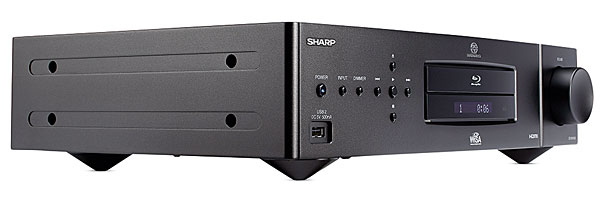
The remote includes a pair of up/down Sound Mode keys, which, when operated, advanced through Direct, Standard, and Mode 1-3 according to the onscreen display. However, since there was no sonic change (nor interruption) what- soever, this did not appear to do anything. The manual was not helpful in describing what each mode would do or under what conditions this control might be active, and as best as I could determine, the SD-WH1000U played back the surround mode and format selected by the source, whether disc or HDMI.
The Bottom Line
Let me step back for a moment and reiterate that I have no qualms about the Sharp player’s potential as a genuinely high-res audio component. Sharp notes several high-end bona fides for the SD-WH1000U, including 96/24 resampling and conversion, playback of high-res files up to a 192-kilohertz sampling rate, ESS9018 D/A hardware (a chip widely endorsed in esoteric circles), and some serious power-supply
and analog-audio circuitry. And everything I heard tended to con-
firm the claims: Reference-grade recordings, in particular the dozen or so DSD files I intensively auditioned from USB media, sounded terrific, wireless or not.
Consequently, WiSA, at least as evidenced by the Sharp/B&O setup I experienced, seems fully ready for serious listening. I watched a handful of movies—and auditioned such discs as the Dolby Atmos demo disc (in non-Atmos Dolby TrueHD, of course), a superb-sounding Blu-ray Disc—and never heard anything short of truly fine sound, nor experienced any sync or video issues other than the rare channel-mute already mentioned.
Fine A/V performance or not, though, as a wireless “WiSA Hub” meant to fill the role that an A/V receiver or pre/pro would take in a modest, conventionally wired system, the SD-WH1000U was simply not ready for prime time. Its superb wireless sonics and Blu-ray performance were not quite enough, in my view, to counterbalance what proved to be unusable music streaming from my network, limited everyday-use fea- tures, several operational roadblocks, and exalted price. Nonetheless, the SD-WH1000U is a first of its kind, and there are bound to be some bumps along the wireless way. Along with a few firmware updates, perhaps, to smooth some of them out. I’ll be keeping a “sharp” eye on the WiSA space; you should too.
